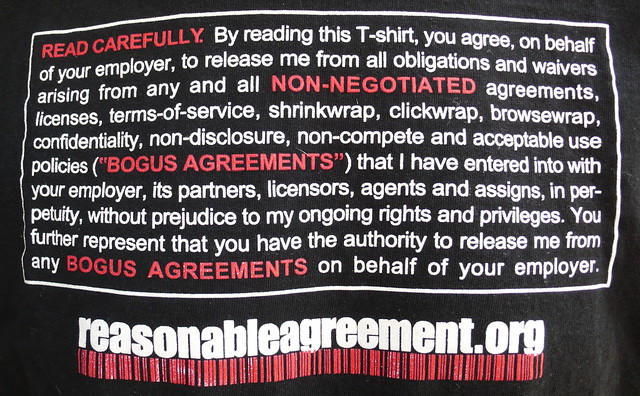By Allie Wang and Bryan Rea
http://www.thedaily.com/page/2011/09/06/090611-tech-technews-itunes-redesign-1-2/
http://www.iagreeto.org/
http://smallprint.netzoo.net/reag/
Does anyone really read the Terms of Service (TOS) or End User License Agreements (EULA) that come with software purchases? Can they really be enforced? If “notice and consent have outlived their usefulness”, as David Vladeck of the FTC says, what is the alternative? With the Sears vs. FTC case and the ProCD vs. Zeidenberg, we have two conflicting interpretations of enforceability. In the Sears case, the FTC argued that, even though the TOS were up front about what was being collected, it was deceptive because the information was buried deep in the TOS and a reasonable person might not truly understand the full extent of the monitoring that was occurring. In ProCD vs. Zeidenberg, the court ruled that as long as a the TOS were reasonable and the purchaser was notified that such TOS existed, even if the purchaser could not possibly have read the terms before purchasing, she has still entered into a contract. Regardless of which is the right interpretation, it is clear that redesigning TOS and EULAs to more accurately inform consumers of the agreements they are entering into would be a good thing.
We found two projects that attempt to change the dynamics of TOS and EULAs to actually benefit the consumer. In the case of Apple’s iTunes, design student Gregg Bernstein created a better user interface for navigating and presenting the information in the TOS and is more explicit about getting consent than today’s clickwrap licenses. In the case of ReasonableAgreement.org, the same questionable tactics that businesses employ to get users to agree to abusive TOS are used to return rights back to consumers.
Bernstein, a graduate student at the Savannah College of Art and Design, revamped Apple’s iTunes click-through TOS, eliminating confusing legal jargon and the unfriendly font in favor of a user-friendly interface. With the help of a law professor, he pared down the original 4,137-word to a mere 381 words. The remaining words were then logically organized into sections for better readability, with numerals, bullet points, and indentations. Users are required to type their initials to agree to TOS on each page, eliminating one of the common problems with clickwrap licenses. The redesign allows the user to see everything she’s agreeing to at a glance and breaks up the agreement into much more manageable chunks. Bernstein has since contacted the legal department at Apple, Adobe, Amazon, Google and Microsoft, but so far has not received any feedback on potentially redesigning TOS for these major tech companies.

The other solution we found is a bit kitschier and comes from ReasonableAgreement.org They created an anti-EULA that reads:
“By [accepting this material | accepting this payment | accepting this business-card | viewing this t-shirt | reading this sticker] you agree on behalf of your employer to release me from all obligations and waivers arising from any and all NON-NEGOTIATED agreements, licenses, terms-of-service, shrinkwrap, clickwrap, browserwrap…”
The organization encourages users to print out stickers, buy the t-shirt or otherwise make use of this anti-EULA in the same slightly deceptive way that businesses get consumers to agree to things they would not normally agree to if they a.) understood the rights they were waiving and b.) were not presumptively agreeing to the terms simply by buying the software. Their hope is that by using this anti-EULA in places where consumers typically sign away their rights, they can tip the balance of power back to users. It is doubtful that the anti-EULA would stand up in court but that’s the point. As they say on the website, “It’s no more enforceable than any of the other dumb-ass, abusive agreements out there but this one works for you. It’s time to stop agreeing. It’s time to come up with some real, reasonable agreements.”

The FTC has a mandate to protect consumers from “deceptive acts and practices” and both Bernstein’s redesigned TOS and ReasonableAgreement.org anti-EULA attempt to overcome the deceptive nature of these agreements. We’ve seen with the Sears case that long, obtuse, and overreaching TOS can be invalidated which means we need a better alternative. The Reasonable Agreement example uses deception to its advantage while Bernstein’s redesign tries to to minimize the deceptive nature of the agreement. The anti-EULA would most likely fail the FTC’s test for deception however Bernstein’s redesign should pass and become a model for what reasonable terms of service look like in the future.
